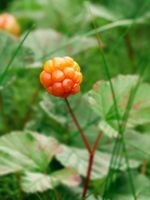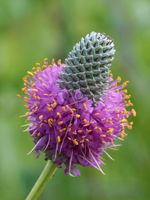Mon-Fri 9am - 5pm Mountain time
Cloudberry vs Purple Prairie Clover
Rubus chamaemorus
Dalea purpurea
NOT AVAILABLE THIS SEASON - MIGHT RETURN
NOT AVAILABLE THIS SEASON - MIGHT RETURN
Cloudberry produces berries which taste tart and tangy with a sweet, floral hint. The berries have a creamy texture when overripe. They are often used to make jams, juices, and liquors. The berries are a pale red colour and when ripe turn more orange/amber. They do not grow very tall, generally reaching only 10-25 cm.
Cloudberry has distinct male and female plants. In order to produce berries, both must be present and pollinate with each other. Berries are produced at maturity, typically 5-7 years, and produce 1 berry per stem. The plant spreads naturally as they grow using modified underground stems (rhizomes), forming more plants over time in the same area.
This plant can be found wild in Canada’s boreal forest. In Newfoundland and Labrador, this plant is known as the Bakeapple and is a significant regional food. Similarly the Côte-Nord region of Quebec also has a long history of using this berry.
Note: Cloudberries require very specific soil conditions. They need well-drained soil with a pH between 3.5 and 5.0. Also sensitive to salt and dry conditions.
Note: Our seedlings are grown from seed and are too young to identify their sex.
Purple Prairie Clover is a native perennial wildflower known for its striking purple blooms. The flower heads grow as dense spikes on tall stems, with each flower head containing many tiny blossoms. Blooming for 4–6 weeks in the summer, it attracts a variety of pollinators, including bees and butterflies.
The high protein content of the Purple Prairie Clover makes it excellent forage for wildlife and birds like to feed on its seeds. As a nitrogen-fixing plant, it enriches the soil, improving fertility and benefiting nearby vegetation. These ecological contributions make it a great choice for pollinator gardens, prairie & rangeland restoration, naturalization, and re-vegetation efforts.
This drought and heat-tolerant plant thrives in various soil conditions, including rocky soil, making it remarkably easy to grow in challenging environments.

